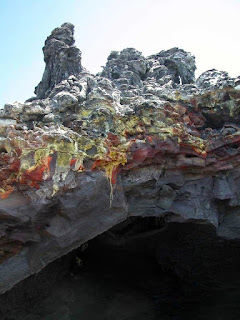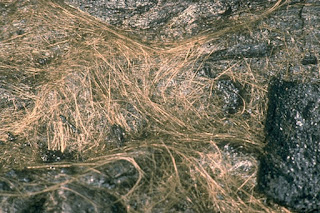My Hawaiian Stone. Balsalt. Just a blob of cooled lava worn smooth by the Pacific!
And a bit of a Black Beach
Which on close inspection has tiny grains of many colors of sand actually. The most surprising thing (to me) about black sand was I expected something coarse, heavy and gritty.
Not so.
Poured a tiny bit from the vial into my hand and it's as silky smooth as sugar white sand from Clearwater.
Saw a model once in an ad lounging bikini-clad on a black sand beach. I am afraid I am entirely too OCD for black sand beaches,myself. It clung to her thigh much the way white or tan sand beaches cling when you are wet. Even seeing it in a photo had the effect of making me want to brush it off.
Started the new painting this week as well.
The Background (beginning)
Layering in the cooled lava and steam and such this week. The flowing magma will come later...and the wave-wash last.
Today's Virtual Adventure will begin with Lava Formations, Stones and Flows.
Pahoehoe
Pahoehoe is thick ropey cooling lava flow. Underneath the magma is still moving and the edge breaks and reforms causing the texture.
A'a
A'a is sharp, spiny, crumbled edges of lava which move along in a jumbled pile.
Block Lava
Block Lava tend to form angular smooth sided blocks when cool.
Lava Domes
Formed by gases the lava rises in a gaseous bubble formation...some of these cool and retain the shape...others burst.
Pillow Lava
Pillow lava is what occurs when the lava originates beneath the ocean...blobbing and cooling quickly in rounded pillow-like forms...hence the name.
A well-known formation that is often explored by tourists is a lava tube.
Lava Tube
Thurston Tube on Big Island is an example. Lava tubes are formed when an area that previously was a lava flow cools and lava stops flowing through it. Cave-like, the first inhabitants of these islands used them for shelter.
Rocks formed in these islands include the sample I have (shown at the very beginning) Basalt...the most common rock on these islands. As well as the most common on Earth. The Hawaiian Islands are primarily built of basalt.
Volcanic Bombs
Which are generally round shaped from flying through the air. These are blobs of lava ejected into the air and cooling and hardening on the way down.
Hornito
Basically spatter or cinder cones.
I have actually been able to see these and the scatter-fields (where pumice is thrown widely around the area) while in the Mojave in California. Although humans were not around when the Mojave eruptions occurred, it is easy to imagine the chaos that an eruption caused when these flaming air-filled stones were falling from the sky.
Lapilli
Smaller than a dime...Lapilli in Italian translates to "little stones".
These are created by the ash in the air during an eruption .
Pele's Seaweed (Limu)
is thin glass like formations that are formed when frothy pahoehoe lava flows into the sea and bubbles burst.
Obsidian
Found in only one area on the Hawaiian Islands, Obsidian is what happens when lava cools so quickly it does not have time to form crystals. It is smooth, glassy and black.
Pele's Hair
A formation I find extremely interesting, and also was able to experience in California.
Pele's hair forms when thin strings of molten rock in the front of a lava flow drip down the side or off a ledge and cool quickly. The result is a tangle of glass strands and is quite amazing.
In Hawaii, Pele's Hair can be found at the Kilauea Crater.
Pumice
Pumice is formed when gases mix with the lava before it cools making it frothy like the fizzy top of a carbonated soda. Once it cools these rocks are surprisingly light (can float on water) and sharp from the tiny shards of glass-like rock throughout them. A small one can remove heel calluses....and a large one can shred your hands if you try to pick it up without gloves. Tiny cuts all over them.
(something I also learned the hard way in Cali)
Learn from my mistake. Use heavy GLOVES for a big piece.
Scatter-fields are full of these in a range of colors from reddish brown to black or grey.
Now back to my painting...
More anon.
















